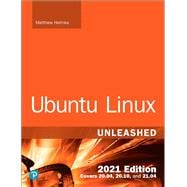Covers 20.04, 20.10, and 21.04
Ubuntu Linux Unleashed 2021 Edition is filled with unique and advanced information for everyone who wants to make the most of the Ubuntu Linux operating system. This new edition has been thoroughly updated by a long-time Ubuntu user and early community leader to reflect the exciting new Ubuntu 20.04 LTS release, with a forthcoming online update mid-2021, at the halfway mark before the next LTS release comes out.
Linux writer Matthew Helmke covers all you need to know about Ubuntu 20.04 LTS installation, configuration, productivity, command-line usage, development, systems administration, server operations, networking, virtualization, cloud computing, DevOps, and more—including intermediate-to-advanced techniques you won't find in any other book.
Helmke presents up-to-the-minute introductions to Ubuntu's key productivity and web development tools, programming languages, hardware support, and more. You will find new or improved coverage of the Ubuntu desktop experience, common web servers and software stacks, an introduction to containers like Docker and Kubernetes, as well as a wealth of systems administration information that is stable and valuable over many years.
- Configure and use the Ubuntu desktop
- Get started with multimedia and productivity applications
- Manage Linux services, users, and software packages
- Administer and run Ubuntu from the command line
- Automate tasks and use shell scripting
- Provide secure remote access and configure a secure VPN
- Manage kernels and modules
- Administer file, print, email, proxy, LDAP, DNS, and HTTP servers (Apache, Nginx, or alternatives)
- Work with databases (SQL) and learn about NoSQL alternatives
- Get started with virtualization and cloud deployment, including information about containers
- Learn about options for managing large numbers of servers, including in the cloud
- Learn the basics about popular programming languages including Python, PHP, Perl, and gain an introduction to new alternatives such as Go and Rust








